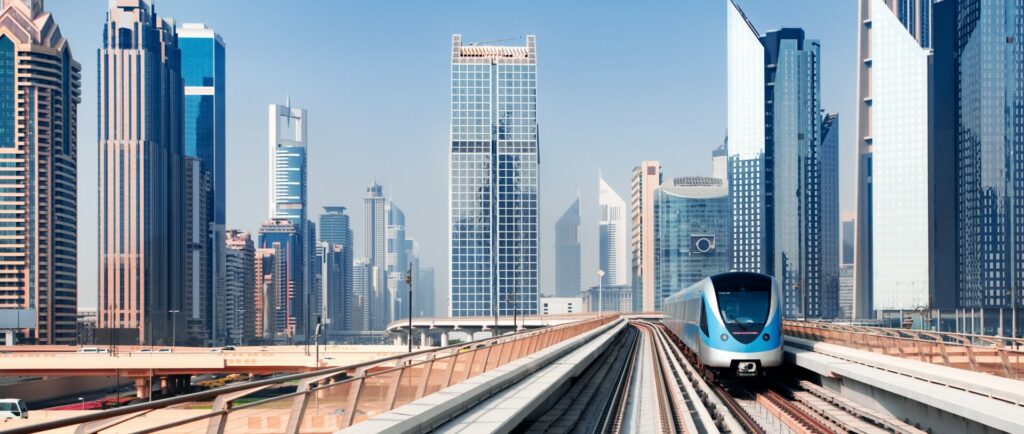Dubai Metro Blue Line: Transforming Real Estate and Connectivity
Dubai’s relentless pursuit of innovation and progress takes another leap forward with the highly anticipated Dubai Metro Blue Line. Slated for completion in 2029 to mark the 20th anniversary of the Dubai Metro, this 30-kilometre extension will significantly enhance connectivity across the city.
More than just a transport initiative, the Blue Line is poised to reshape real estate values, boost economic activity, and streamline urban mobility.

A Game Changer for Dubai’s Infrastructure
The Dubai Metro has played a pivotal role in the city’s development since its launch in 2009. The addition of the Blue Line underscores the government’s commitment to seamless public transport solutions, aligning with the Dubai 2040 Urban Master Plan. With a goal to have 55% of residents within 800 metres of mass transit stations, the Blue Line will serve as a critical component of this vision, fostering sustainable growth and accessibility.
The 30-kilometre track will include 14 stations, with 15.5 kilometres running underground and 14.5 kilometres elevated. This will allow for smooth integration with the existing Red and Green Metro Lines, enhancing connectivity for millions of residents and visitors. One of its most remarkable engineering feats will be a 1,300-metre viaduct crossing Dubai Creek, a first in the city’s metro system.
Boosting Real Estate Value For Property Owners in Dubai
Historically, proximity to metro stations has been a key driver of real estate value in Dubai. The Blue Line is expected to push property prices up by as much as 25% in surrounding areas, offering lucrative opportunities for investors and homeowners alike. Areas along the route, including Dubai Festival City, Dubai Creek Harbour, Ras Al Khor, Dubai International City, Dubai Silicon Oasis, and Academic City, are set to experience heightened demand, particularly for off-plan developments.
With the upcoming expansion, property buyers in Dubai have an opportunity to secure units at pre-surge prices, ensuring strong long-term returns. The increased accessibility will also make these areas more attractive to businesses and residents, fostering vibrant communities along the metro’s path.
Strategic Connectivity and Key Interchange Points
The Blue Line’s route has been carefully planned to enhance Dubai’s urban transit network. Key interchange stations will enable seamless transfers between lines, further solidifying the metro as the backbone of Dubai’s public transport.
Major interchange points include:
- Creek Station (Green Line) – Linking to Dubai’s southern transit network.
- Centrepoint Station (Red Line) – Providing direct access to key business districts.
- Dubai International City Station 1 – A crucial hub facilitating urban expansion.
These strategic connections will significantly reduce commute times and traffic congestion, supporting Dubai’s ambition of becoming a ‘20-minute city’ where 80% of essential services are accessible within a short travel radius.
Dubai’s commitment to cutting-edge infrastructure is clearly reflected in the Blue Line’s design. The project includes:
- An iconic station at Dubai Creek Harbour, designed by globally renowned architects.
- A vast underground interchange station in International City, capable of handling 350,000 passengers daily.
- A metro depot in Al Ruwayyah 3, supporting future expansions and rolling stock maintenance.
With a capacity of 56,000 passengers per hour in both directions and a service interval of just 1.5 minutes, the Blue Line aims to provide a world-class commuting experience. This aligns with Dubai’s broader agenda of achieving 30% driverless public transport by 2030.
Implications for Urban Growth and Economic Impact
The Blue Line is not just a transportation project. It is an economic catalyst. Dubai’s population is expected to reach 5.8 million by 2040, with a daytime working population of 7.8 million. The expansion of the metro is crucial to meeting the mobility demands of this growing city.
By 2030, the Blue Line is expected to serve 200,000 passengers daily, increasing to 320,000 by 2040. This will translate into significant savings in travel time and fuel consumption, reducing carbon emissions and improving overall quality of life. Additionally, initial studies by the Roads and Transport Authority (RTA) project total economic benefits of AED 56.5 billion by 2040, making the Blue Line a sound investment for Dubai’s future.
The Road to Completion
The project’s execution timeline is well-structured:
- 2025: Tunnel boring begins to create the underground corridor.
- 2028: Trial operations commence.
- 2029: Official launch, coinciding with Dubai Metro’s 20th anniversary.
The estimated AED 18 billion investment will extend Dubai’s metro network to 131 kilometres, encompassing 78 stations and 168 trains, reinforcing its reputation as a global leader in public transportation.
A Future-Ready Dubai For Savvy Real Estate Investors
By bridging key districts, enhancing real estate value, and driving sustainable urban mobility, Dubai Metro Blue Line cements Dubai’s standing as a forward-thinking metropolis.
As 2029 approaches, investors, homeowners, and businesses should take note of the immense opportunities the Blue Line presents. Whether through strategic property investments or improved connectivity, this landmark development will leave an indelible mark on Dubai’s urban evolution.
Get in touch with us to leverage the impact of Dubai Metro Blue Line at the right time and the right place.
